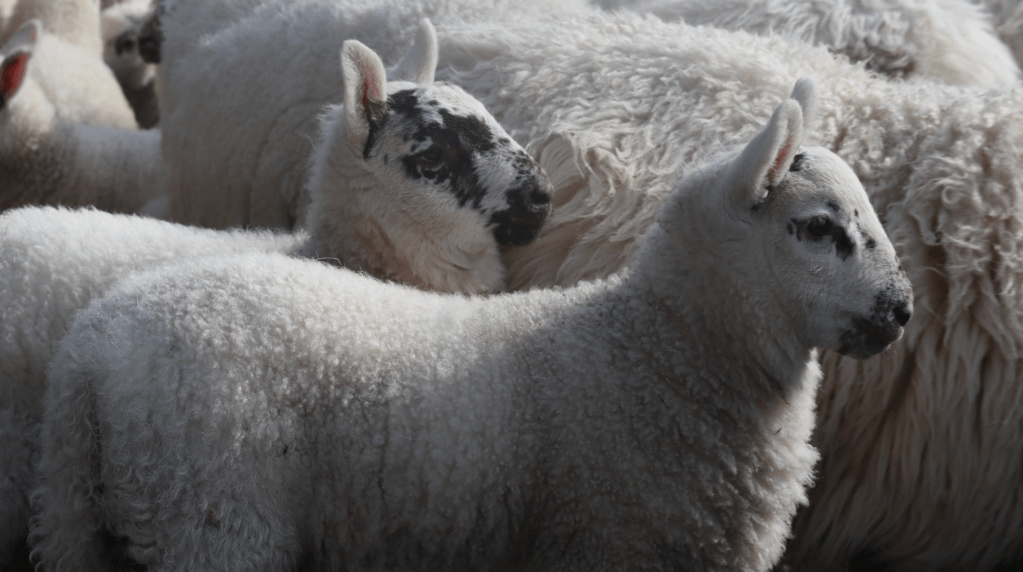
We gathered the lambs and brought them all to a pen by the roadside hedge. It’s astonishing to see how these animals have grown in the month since they were born. You’d hardly believe it was possible for creatures to spring out of the ground like dragon’s teeth and chew their way through progress in such gigantic bites. Mule lambs are famously vigorous and bold, but I‘ve never seen it play out before me like this – how they turned from fragile strands of wire and skin to powerful blocks of daring enthusiasm in time so brief and ordinary that you or I would hardly mark its passing.
The lambs look big, but they’re light as pillows. I was ready to handle a weight of muscle and bone, so the first one I picked up was almost thrown over my shoulder like a feather. It seems they’re big before they’re full, and all they’ve done is lay down “frame” to flesh out in the coming summer. So what I have is bags which will go on to fill themselves, and it reminded me of little cod which grow from the mouth first to be sure that nothing is ever too big to be eaten.
I don’t know their mothers as individuals. The blackface sheep only came to me in October, and they’ve been specks on the far horizon since then. But their father lives in a pen beneath my office window; I see him every day and in every weather, and I’m never bored of him – nor do I regret the extra cash I paid to take him from the best pen on the hills above Carnwath. The ewes have written a mess of greyface markings all over their lambs; some have snow white masks with speckled noses, while others are grey or shaggy roan to the line of their jaw. They’re a mix and a muddle, but every single one of these lambs has the shape of its father’s head stamped upon it – long, back-curved ears and a deliciously pleasing dome at the brow. Their heads are the size and thickness of your own knee when you crouch to gather them, and each one beckons to be cupped with a downturned palm.
You can enjoy these animals at all levels – from simply “look, they’re alive” to drier points of technical discernment. Some of these animals are as good as any greyface lambs you’ll find in Scotland today – others are little more than fine. And the same is true of the credit I can claim for the success of these lambs, which permits both a sense of pride to myself and a wider feeling that I am only reaping the inevitable conclusion of tradition and biological fact. I am no more responsible for the excellence of mule lambs than a child who mixes blue paint with yellow and crows that he’s discovered green – and yet in the moment of mixing, that green is his own.
Cows are so big and their births such grand events that each one lands like a footstep in a slow and steady plod. You remember the circumstances of each new calf and the way its mother turned or let you tag it. But these lambs came in a machine-gun rattle; a purr of activity which felt like a single, coherent event. And now there are loads of them; triplets and twins and never-before-seen animals which come tripping down from the nodding bog. Each time I handle these animals, I notice new and different markings which are present for a moment and then lost again in the churning anonymous mass. And I’m not sure I’ve ever felt such pride at having been part of something so worthwhile as this little crop of lusty lambs which pooled and panicked in the pens, feeling better for their anonymity, and closer to a “crop” than anything I ever made of beef.
Sheep are so often criticised and despised these days, and I read one conservationist who believes that “we need to have a difficult conversation about the future of hill farming”. The man’s a prick and he’s being disingenuous in the pained sharing of an uneven load and a false readiness to compromise – because “we” are not having a difficult conversation if you’re telling me that I’m out of business. But perhaps there’s truth in the wider argument, and lots of people say that we have too many sheep and nobody’s eating lamb much anymore. The facts are hard to counter, but standing up to your knees in a pen of your own lambs, you’d be hard pressed to think of any work that is more worthy of your time and attention.
If the money’s cut from the throat of sheep in the hills, most people will stop keeping them only because the power goes off in the house and the cupboard is suddenly bare. There are better reasons than money to do this work, and it’s wrong that cash has come to underpin it.
Leave a comment